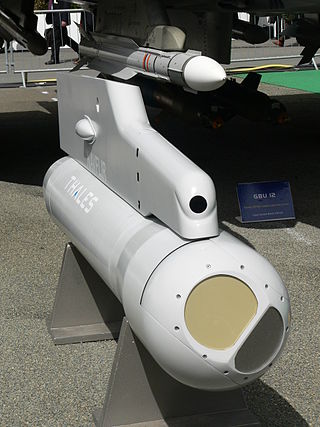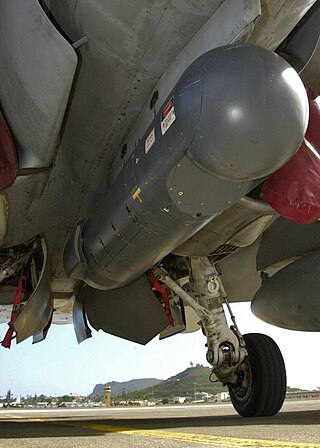
The Thermal Imaging Airborne Laser Designator (TIALD) was a targeting pod manufactured by Ferranti/GEC Marconi in the late 1980s and 1990s, and was the UK's primary laser designator for its Paveway series of laser-guided bombs (LGBs).

LANTIRN is a combined navigation and targeting pod system for use on the United States Air Force fighter aircraft—the F-15E Strike Eagle and F-16 Fighting Falcon manufactured by Martin Marietta. LANTIRN significantly increases the combat effectiveness of these aircraft, allowing them to fly at low altitudes, at night and under-the-weather to attack ground targets with a variety of precision-guided weapons.

Directional Infrared Counter Measures (DIRCM) are a class of anti-missile systems produced to protect aircraft from infrared homing missiles, primarily MANPADS and similar simple systems.

The Lockheed Martin AN/AAS-35(V) Pave Penny is a laser spot tracker carried by US Air Force attack aircraft and fighter-bombers to enable them to track a laser spot on the ground. It is a receiver only, allowing the pilot to see which targets may be attacked by any laser-guided bombs they carry.

The Lockheed Martin Sniper is a targeting pod for military aircraft that provides positive target identification, autonomous tracking, GPS coordinate generation, and precise weapons guidance from extended standoff ranges.

Targeting pods (TGP) are target designation tools used by attack aircraft for identifying targets and guiding precision-guided munition (PGM) such as laser-guided bombs to those targets. The first targeting pods were developed in conjunction with the earliest generation of PGMs in the mid-1960s.

The AN/AAQ-28(V) Litening targeting pod is an advanced precision targeting pod system currently operational with a wide variety of aircraft worldwide. The research and development of the Litening was first undertaken by Rafael Advanced Defense Systems' Missiles Division in Israel, with subsequent completion of Litening I for use in the Israeli Air Force.

The Changhe Z-10 is a Chinese medium attack helicopter developed for the People's Liberation Army Ground Force. It is designed primarily for anti-tank warfare missions but has secondary air-to-air combat capability as well.

The Sukhoi Su-30MKK is a modification of the Sukhoi Su-30, incorporating advanced technology from the Sukhoi Su-35 variant. The Su-30MKK was developed by Sukhoi in 1997, as a result of a direct Request for tender between the Russian Federation and China. It is a heavy class, all-weather, long-range strike fighter, and like the Sukhoi Su-30, comparable to the American McDonnell Douglas F-15E Strike Eagle. The Sukhoi Su-30MK2 is a further improvement to Su-30MKK with upgraded avionics and maritime strike capabilities. The MKK and MK2 are currently operated by the People's Liberation Army Air Force, Indonesian Air Force, Vietnam People's Air Force, Venezuelan Air Force and the Ugandan Air Force.

The C-704 is a Chinese anti-ship missile. The missile was developed by the third research institute of the Chinese Aerospace Group, also the manufacturer of the C-701.
TY-90 is a Chinese air-to-air missile specifically developed for attack helicopter dogfights. Contrary to erroneous claims, the missile is not developed from MANPADS missiles, but instead, it is specifically designed as an air-to-air missile to engage in helicopter combat.
Blue Sky is a combined airborne navigation and targeting pod system for Chinese military aircraft. It is designed to provide aircraft with all-weather/night-attack capabilities. It is the Chinese equivalent of the United States Air Force LANTIRN system. Several derivatives have already been developed since its public debut.
The Xi'an MA700 is a twin-engine, medium-range turboprop airliner currently under development by Xi'an Aircraft Industrial Corporation of the Aviation Industry Corporation of China (AVIC).
LT PGB is an abbreviation for a family of Chinese built precision guided munitions named Fury Precision-guided munition developed by Luoyang Electro-Optics Technology Development Centre (EOTDC), a subsidiary of China Aerospace Science and Technology Corporation (CASC). Alternatively, LT PGB is also referred by its laser guidance, as Fury laser-guided bomb, or LT LGB.

LS is an abbreviation for a family of Chinese built precision-guided munitions (PGM) named Thunder Stone Precision Guided Bomb developed by Luoyang Electro-Optics Technology Development Centre (EOTDC), a subsidiary of China Aerospace Science and Technology Corporation (CASC). Alternatively, the LS PGB is also referred to by its gliding capability, as Thunder Stone Gliding Guided Bomb, or LS GGB. The guidance design of LS PGB is also adopted for another family of Chinese PGM, the YZ series, such as YZ-102 series. These PGMs are referred to in China as precision guided bombs (PGB).

The Chengdu GJ-1, also known as Wing Loong 1, is a Medium-Altitude Long-Endurance (MALE) unmanned aerial vehicle (UAV), developed by the Chengdu Aircraft Industry Group in the People's Republic of China. Intended for use as a surveillance and aerial reconnaissance platform, the Pterodactyl I is capable of being fitted with air-to-surface weapons for use in an unmanned combat aerial vehicle (UCAV) role.

The Shenyang FC-31Gyrfalcon, also known as the J-31 is a Chinese prototype mid-sized twinjet 5th-generation fighter aircraft developed by Shenyang Aircraft Corporation (SAC). The official nickname published by SAC is "Gyrfalcon", though it has also been referred to as the "F-60" or "J-21 Snowy Owl" in some media reports, or "Falcon Hawk" by some military enthusiasts. J-XX nomenclatures in the Chinese military are reserved for programs launched and financed by the People's Liberation Army, while the FC-31 plane was developed independently as a private venture by the aircraft manufacturer.

The Wing Loong-10 is a series of unmanned aerial vehicles of the High-Altitude Long Endurance (HALE) type, featuring some stealth characteristics. As of 2017, it is being developed by the Chengdu Aircraft Industry Group for reconnaissance and precision strike missions.

The Chengdu GJ-2, also known as Wing Loong 2, is an unmanned aerial vehicle (UAV) capable of remotely controlled or autonomous flight developed by the Chengdu Aircraft Industry Group in the People's Republic of China. Intended for use as a surveillance and aerial reconnaissance and precision strike platform, Chengdu unveiled the concept of Wing Loong II at the Aviation Expo China in Beijing in September 2015. Wing Loong II has long range strike capability with a satellite link.














